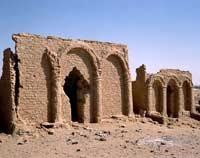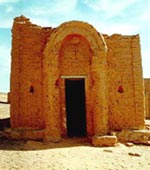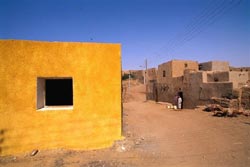|
Kharga Oasis is the
last oasis on the loop before the Nile Valley. It seems to have
had the longest association with ancient Egypt. It is also the
place where Christians were banished in the 4th and 5th
centuries and as a souvenir of the time boasts one of the
largest ancient Christian cemeteries in the world: Bagawat.
Kharga also claims the first five star resort with swimming pool
and air conditioning. At first glance Kharga looks disappointing
for its main village is a replica of a Nile Valley town, but one
must dig deeper.
 Kharga used to be the last but one stop of The Forty Days Road,
the infamous slave-trade route between North Africa and the
tropical south. Today, it is the biggest New Valley oasis and
its modern city houses 60,000 people, including 1,000 Nubians
who moved here after the creation of lake Nasser. Kharga used to be the last but one stop of The Forty Days Road,
the infamous slave-trade route between North Africa and the
tropical south. Today, it is the biggest New Valley oasis and
its modern city houses 60,000 people, including 1,000 Nubians
who moved here after the creation of lake Nasser.
Outside the main center is the Temple of Hibis, built on the
site of an 18th dynasty settlement of Saites, Persians and
Ptolemies. One of the few Persian monuments in Egypt, the 6th
century BC temple is well preserved with painted vultures and
huge reliefs of Darius greeting Egyptian gods on the outer
walls. The temple is dedicated to the Theban triad, consisting
of the gods, Amun, Mut and Khonsu, who's reliefs are in very
good condition.
Ten kilometers away, the Necropolis of al-Bagawat contains 263
tombs (mostly dating from the 4th through 6th centuries, AD) in
the pattern of domed chambers, as well as 120 Nestorian mud
brick chapels where the dead could be worshipped.. Some of the
tombs have paintings of biblical scenes. In the center is a
church dating back to the 11th century AD. It is regarded as one
of the oldest churches in Egypt.
 Some of the more interesting structures located here include the
Chapel of Peace, with paintings of the apostles and with images
of Adam and Eve and the Ark on it's dome. There is also the
Chapel of Exodus, with better preserved pictures, and Old
Testament biblical stories as well as frescoes of pharaonic
troops pursuing the Jews, led by Moses, out of Egypt. Another
example is the Chapel of the Grapes, with paintings of
grapevines. Pharaonic monuments include the al-Ghuwaytah Temple
which dates from 522 BC and the Temple of Amenebis. Some of the more interesting structures located here include the
Chapel of Peace, with paintings of the apostles and with images
of Adam and Eve and the Ark on it's dome. There is also the
Chapel of Exodus, with better preserved pictures, and Old
Testament biblical stories as well as frescoes of pharaonic
troops pursuing the Jews, led by Moses, out of Egypt. Another
example is the Chapel of the Grapes, with paintings of
grapevines. Pharaonic monuments include the al-Ghuwaytah Temple
which dates from 522 BC and the Temple of Amenebis.
The thermal springs at Bulaq and Nasser villages to the south,
are famous for water temperatures of up to 43 C and reputed to
be suitable for the treatment of rheumatism and allergies.
Camping facilities are available near both villages.
Further south is Baris Oasis, the second largest settlement in
Kharga. Houses designed in traditional Nubian style.
Ancient monuments include the Temple of Dush, dedicated to Isis
and Serapis. Its name derives from Kush, the ancient Sudanese
capital which traded with Egypt along the Nile. Dush was a
religious, military and civilian complex that primarily
developed as the result of the slave trade, and was a staging
point for caravans that either headed to Assiut or Esna.
 Built for Isis and Serapis, this temple is surrounded by a
mud-brick fortress. It was built during the rule of Domitian and
Trajan (1st century) and decorated during the rule of Hadrian,
though apparently the site was occupied from the Ptolemaic
period. Entering the temple through any one of several gates is
the barrel-vaulted sanctuary which is made up of two connecting
rooms and has a vaulted ceiling. On either side of the sanctuary
are chapels. Built for Isis and Serapis, this temple is surrounded by a
mud-brick fortress. It was built during the rule of Domitian and
Trajan (1st century) and decorated during the rule of Hadrian,
though apparently the site was occupied from the Ptolemaic
period. Entering the temple through any one of several gates is
the barrel-vaulted sanctuary which is made up of two connecting
rooms and has a vaulted ceiling. On either side of the sanctuary
are chapels.
Archeologists are still unearthing the ancient city of Kysis and
elaborate system of clay pipes and abandoned Christian church,
suggest that Kysis was abandoned when its underground springs
dried up but the exact date remains a mystery
Kharga Oasis’s greatest treasures, in addition to its marching
rows of crescent sand dunes, are the Roman fortresses scattered
along a famous slaver’s road called the Darb el Arbain, the 40
Days’ Road. These unexplored fortresses rise to four and five
stories. And there are dozens of them.
Popular Safari Places in Western Desert : |